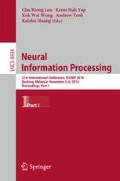Abstract
Pathway provides a deep insight into the mechanism of the biological process. With the increasing of high-throughout gene expression monitoring technology, a lot of data driven methods have been proposed to reconstruct the pathways from the observation data. Low reliability of the discovered results, especially the direction of the regulatory relation, is the main challenge of the existing methods. In this work, a level-wise causal search (LWCS) based disease pathway discovery method is proposed. The following three steps are conducted in each searching level of LWCS to locate the causal variables: firstly, in the parents and children (PC) discovery step, structure learning approach is employed to discover the candidate causal genes; then, in the casual direction learning step, additive noise models are explored to determine the direction of the edges, finally, the trivial causal candidates are pruned and not contained in the further level search. The proposed method is tested and verified on real life gene expression data sets. The success of the proposed method reflects that the causality is a proper model to present the regulatory relations among the genes and phenotypes.
Access this chapter
Tax calculation will be finalised at checkout
Purchases are for personal use only
Preview
Unable to display preview. Download preview PDF.
References
Alon, U., Barkai, N., Notterman, D.A., Gish, K., Ybarra, S., Mack, D., Levine, A.J.: Broad patterns of gene expression revealed by clustering analysis of tumor and normal colon tissues probed by oligonucleotide arrays. Proceedings of the National Academy of Sciences 96(12), 6745–6750 (1999)
Barabási, A.-L., Gulbahce, N., Loscalzo, J.: Network medicine: A network-based approach to human disease. Nature Reviews Genetics 12(1), 56–68 (2011)
Bromberg, F., Margaritis, D.: Improving the reliability of causal discovery from small data sets using argumentation. Journal of Machine Learning Research, 301–340 (2009)
Cai, R., Hao, Z., Yang, X., Wen, W.: An efficient gene selection algorithm based on mutual information. Neurocomputing 72(4), 991–999 (2009)
Cai, R., Zhang, Z., Hao, Z.: Bassum: A bayesian semi-supervised method for classification feature selection. Pattern Recognition 44(4), 811–820 (2011)
Cai, R., Zhang, Z., Hao, Z.: Causal gene identification using combinatorial v-structure search. Neural Networks 43, 63–71 (2013)
Cai, R., Zhang, Z., Hao, Z.: Sada: A general framework to support robust causation discovery. In: ICML, pp. 208–216 (2013)
Cookson, W., Liang, L., Abecasis, G., Moffatt, M., Lathrop, M.: Mapping complex disease traits with global gene expression. Nature Reviews Genetics 10(3), 184–194 (2009)
Dondelinger, F., Lèbre, S., Husmeier, D.: Non-homogeneous dynamic bayesian networks with bayesian regularization for inferring gene regulatory networks with gradually time-varying structure. Machine Learning 90(2), 191–230 (2013)
Drew, B.A., Burow, M.E., Beckman, B.S.: Mek5/erk5 pathway: the first fifteen years. Biochimica et Biophysica Acta (BBA)-Reviews on Cancer 1825(1), 37–48 (2012)
Dudoit, S., Yang, Y.H., Callow, M.J., Speed, T.P.: Statistical methods for identifying differentially expressed genes in replicated cdna microarray experiments. Statistica Sinica 12(1), 111–140 (2002)
Friedman, N., Linial, M., Nachman, I., Pe’er, D.: Using bayesian networks to analyze expression data. Journal of Computational Biology 7(3-4), 601–620 (2000)
Guyon, I., Weston, J., Barnhill, S., Vapnik, V.: Gene selection for cancer classification using support vector machines. Machine Learning 46(1-3), 389–422 (2002)
Haibe-Kains, B., Olsen, C., Djebbari, A., Bontempi, G., Correll, M., Bouton, C., Quackenbush, J.: Predictive networks: A flexible, open source, web application for integration and analysis of human gene networks. Nucleic Acids Research 40(D1), 866–875 (2012)
Hoyer, P.O., Janzing, D., Mooij, J.M., Peters, J., Schölkopf, B.: Nonlinear causal discovery with additive noise models. In: Neural Information Processing Systems, pp. 689–696 (2008)
Kalisch, M., Bühlmann, P.: Estimating high-dimensional directed acyclic graphs with the pc-algorithm. The Journal of Machine Learning Research 8, 613–636 (2007)
Kotera, M., Yamanishi, Y., Moriya, Y., Kanehisa, M., Goto, S.: Genies: Gene network inference engine based on supervised analysis. Nucleic Acids Research 40(W1), W162–W167 (2012)
Minoche, A.E., Dohm, J.C., Himmelbauer, H., et al.: Evaluation of genomic high-throughput sequencing data generated on illumina hiseq and genome analyzer systems. Genome Biol. 12(11), R112 (2011)
Mooij, J., Janzing, D., Peters, J., Schölkopf, B.: Regression by dependence minimization and its application to causal inference in additive noise models. In: ICML, pp. 745–752. ACM (2009)
Pearl, J.: Causality: models, reasoning and inference, vol. 29. Cambridge University Press (2000)
Pearl, J., Verma, T.S.: A theory of inferred causation. Studies in Logic and the Foundations of Mathematics 134, 789–811 (1995)
Peng, H., Long, F., Ding, C.: Feature selection based on mutual information criteria of max-dependency, max-relevance, and min-redundancy. IEEE Transactions on Pattern Analysis and Machine Intelligence 27(8), 1226–1238 (2005)
Peters, J., Janzing, D., Scholkopf, B.: Causal inference on discrete data using additive noise models. IEEE Transactions on Pattern Analysis and Machine Intelligence 33(12), 2436–2450 (2011)
Piersanti, S., Martina, Y., Cherubini, G., Avitabile, D., Saggio, I.: Use of dna microarrays to monitor host response to virus and virus-derived gene therapy vectors. American Journal of Pharmacogenomics 4(6), 345–356 (2004)
Ruan, J., Dean, A.K., Zhang, W.: A general co-expression network-based approach to gene expression analysis: Comparison and applications. BMC Systems Biology 4(1), 8 (2010)
Shipp, M.A., Ross, K.N., Tamayo, P., Weng, A.P., Kutok, J.L., Aguiar, R.C., Gaasenbeek, M., Angelo, M., Reich, M., Pinkus, G.S., et al.: Diffuse large b-cell lymphoma outcome prediction by gene-expression profiling and supervised machine learning. Nature Medicine 8(1), 68–74 (2002)
Viswanathan, G.A., Seto, J., Patil, S., Nudelman, G., Sealfon, S.C.: Getting started in biological pathway construction and analysis. PLoS Computational Biology 4(2), e16 (2008)
Zhang, K., Peters, J., Janzing, D., Schölkopf, B.: Kernel-based conditional independence test and application in causal discovery. In: UAI, pp. 804–813 (2011)
Author information
Authors and Affiliations
Editor information
Editors and Affiliations
Rights and permissions
Copyright information
© 2014 Springer International Publishing Switzerland
About this paper
Cite this paper
Cai, R. et al. (2014). A Causal Model for Disease Pathway Discovery. In: Loo, C.K., Yap, K.S., Wong, K.W., Teoh, A., Huang, K. (eds) Neural Information Processing. ICONIP 2014. Lecture Notes in Computer Science, vol 8834. Springer, Cham. https://doi.org/10.1007/978-3-319-12637-1_44
Download citation
DOI: https://doi.org/10.1007/978-3-319-12637-1_44
Publisher Name: Springer, Cham
Print ISBN: 978-3-319-12636-4
Online ISBN: 978-3-319-12637-1
eBook Packages: Computer ScienceComputer Science (R0)

